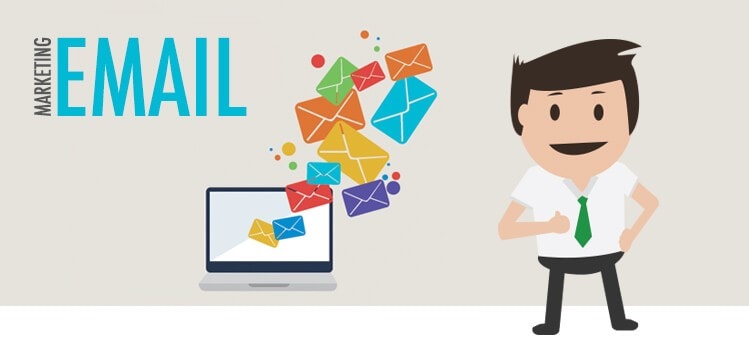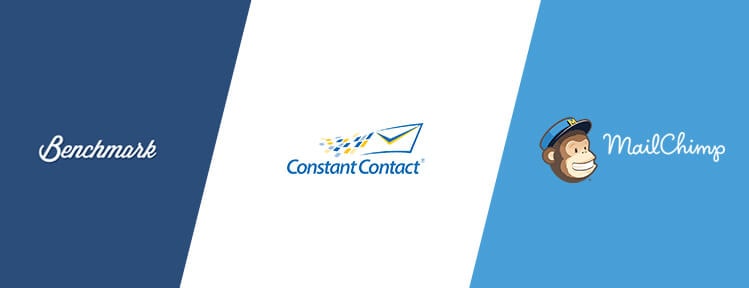Email Marketing Guide for Realtors and Loan Officers
Businesses everywhere are taking advantage of this effective marketing strategy. Have you joined them?
While you may be caught up in Facebook Posts, mailers, Tweets, and blogs, you can’t forget about reaching your clients through email: the messenger that started it all.
Even with all of the innovative communication options available, everyone still uses email, which is why you need to cater to this huge audience and create campaigns that will build stronger relationships with your current clients and gain new clients, all while continuing to grow your business.

Why should I use email marketing for my business?
If you truly want to reach a bigger audience with news and information about your company, then email marketing is the way to go.
Provide your target audience with information that is useful and can be shared across the web to promote your brand and gain leads. When it comes to marketing for your business, email is the most effective way of increasing your outcomes and growing your business.
If you aren’t completely convinced yet, here are some reasons why you should implement email marketing in your mortgage business:
- There are more than 3.2 billion active email accounts today. 95% of online customers use email and 91% check their email daily.
- Your message won’t be missed because it’s directly delivered to your desired recipient. You’ll have a greater reach overall with email.
- Emails have a longer life span because they sit inside your subscriber’s inbox, whereas a Tweet on Twitter will quickly get lost in the bunch. Email is forever … until it’s deleted, of course.
- You can gain a greater return on investment. According to the 2013 Email Benchmark Report, 60% of marketers say that email is producing a return on investment (ROI) and 32% believe it will eventually.
- Your email and social media don’t have to be separated. The great part about email is, you can connect your email campaign to your social media platforms. The more views, the more business!
How do I get started?
If you’ve been staring at a blank email template trying to come up with something valuable to write, don’t worry: you’ll soon be well on your way to creating engaging and useful content for your faithful subscribers.
With that said, let’s jump right in and get you started on creating your campaign.
Your first step is to create your contact list. If you’re in the mortgage business, you probably have stacks of business cards buried in your desk drawer.
To create your list, put all of your contacts into a Microsoft Excel Spreadsheet. This might seem like a daunting task in the beginning, but once you tackle the hard part, you’ll always have that list to manage. So, if another contact comes along, all you have to do is update your list. Make sure to include the first & last names, along with an email address to make it easier on yourself when you’re managing your lists later.
Okay, so now you have your list. Your next step is to ensure that you have the permission of your contacts to send them your emails. Do not skip this step. Most providers require that your lists are permission-based, meaning your subscribers have either signed up through a mailing list or gave you permission to be added.
If you send contacts email without their consent, you’ll violate the CAN-SPAM Act (yes, this is a real thing) and you certainly don’t want to do that.
Here are some basic guidelines of the act to abide by:
- Don’t use misleading information
- Don’t use deceptive subject lines
- Identify your message as an ad
- Inform all recipients of your location
- Make it simple for recipients to unsubscribe and honor those requests promptly
- Monitor those who are taking care of your email marketing for you
If this list got you worried, don’t sweat it. Simply follow these guidelines and your chosen email provider should take care of the rest. For example, with Benchmark, you can’t send emails unless you provide your location, and you can’t upload a list until you confirm that you have permission from your contacts. These reminders prevent you from violating the CAN-SPAM Act.
Most providers make it very easy to upload your contact list(s). You can either do it manually (that could take awhile) or upload your organized spreadsheet that you’ve taken the time to put together in Excel, and it will sort all of your contacts for you.
Now that we have that settled, it’s time to come up with some great content.
What do I write?

How many times do you open an email and click right out of it because it reads as spam or like it was generated from a computer?
Just like with blogging, your content needs to be useful to your subscribers and show that you care about their mortgage and refinance needs.
You want to establish a connection with your audience, especially if you want to avoid seeing your lists of opt-outs grow after every campaign you send.
Be personable. Let your audience know that they can come to you for any questions or information. Provide your contact information in the email to help them do so.
When you’re in the mortgage business, make it your goal to inform your subscribers of any new mortgage programs that are available, the latest mortgage news, and advice for real estate agents because you’re also looking to create long-lasting partnerships.
How often should I send out my campaign?
First things first: There is no “best answer” to this question. However, there are some tips to give you a general idea.
Some business send out an email campaign everyday and have success, while others are better off sending one or two campaigns a week, at most.
So, what do you do?
If you’re looking for some guidance when sending campaigns, consider this:
You should send an email campaign at least once a month. If you wait any longer than this, you’ll lose your consistency and your emails will be too far apart to keep your company in the minds of your customers. If you do choose to send only one email per month, make sure it’s around the same time every month, so your audience knows when to look for it. A great subject for this type of email could be a monthly newsletter.
Keep your email campaigns at about a maximum of once per week to start. If you send out more than this, you could risk multiple opt-outs and your content could come off as spam. If you’re new to the email marketing scene, play it safe and keep it at once per week until you build a stronger relationship with your audience and they want more.
Don’t waste too much time worrying about when to send your campaigns. It’s most important to place more focus on what goes into your campaigns. At the end of the day, it’s all about the content.
What’s the ideal length?

So, how long exactly should your campaign be?
You don’t want to put your audience to sleep with boring text, and yet you don’t want to provide information that isn’t valuable enough for them to take a second look.
Make it your goal to be short, yet effective with your content. Most people that read emails scan it for a few seconds to see if it’s valuable to them and then shut it down if the blocks of text are too long. Who has time for that? Your email content should be easy to read, visually engaging, and attention-grabbing if you want your campaign to succeed.
A good rule of thumb is to keep your emails at a maximum of a page length, and not to go any further (save it for your blog posts). Keep all of your most valuable information “above the fold”, or as we call it online, “above the scroll”.
What subject lines should I use?
Choosing a good subject line is no easy task. What words can you use to help your campaign receive the highest open rate?
If your subject line is dull, you can expect users to send that message with all of their other spam into the trash, as well as an opt-out for any future emails.
As a frequent email user yourself, take a look into your own inbox. What kind of subject lines grab your attention? Use these lines as inspiration for your business, and do a little experimenting to see what subjects get you the highest open rate.
For example, try starting out with a subject line involving your business name. Here are a few examples:
- Neighborhood Loans Marketing Newsletter
- Neighborhood Loans Welcomes You!
- Season’s Greetings from Neighborhood Loans!
Just like with social media, you can’t make your content all about promoting your business. When you’re sharing content that doesn’t pertain to promoting your business, here are a few subject lines that could work to your benefit:
Reasons why: “5 Reasons Why You Should Hire a Home Inspector”
Benefits: “Write an Amazing Blog in Less Than 2 Hours”
Questions: “Are You Using this Effective Marketing Strategy?
How-to’s: “How to Gain More Leads to Your Business”
Make it your goal to show a glimpse of content that will be useful to them, so that they want to read more. If you convey a sense of urgency in your subject line, you’ll grab the attention of your audience and increase your chance of receiving a higher open rate.
Don’t forget to follow through with whatever you’re promising in your subject line. If a subscriber sees that you’re using words just to get them to open an email, you’ll lose their trust and their subscription.
Also, tread carefully with your subject lines and avoid using words like “free”, “act now”, “earn”, “discount”, “buy”, and other typical spam phrases that would make you send an email right to the trash.
When writing your subject line, think carefully. What would make you want to open an email?
What provider should I use?

You’re definitely not going to send each email one-by-one from your account. That’s why you need to find an email provider to save you time, and offer you awesome templates to take your campaign to the next level.
Before you choose the right program for you, you’ll need to determine the size of your target audience, because if you have a huge audience, it might cost you to reach them.
If you’re new to this whole email marketing thing, consider the following providers that are most popular and easy to use:
Benchmark Email
Benchmark Mail is a permission-based email marketing company that holds strong values to its user deliverability and reputation. Using Benchmark is probably your best bet in the mortgage business, because of its user-friendly and customizable templates.
Advantages:
- You can easily manage your contacts lists, whether you need to delete or add subscribers.
- You can further boost the visibility of your email campaign across all of your social networks through adding platforms like Twitter, Facebook, Google+,Digg, and any other links you’d like to have to your email campaigns.
- When you use Benchmark, you’re even provided with a visual of where your subscribers are located.
- You can create newsletters, surveys, upcoming event information, and coupons for your business all in one place.
- You can manage and create new accounts. For example, if you have multiple mortgage bankers that need to reach their realtors, they can each have their own contact lists to get the desired message to an even larger audience. You can manage numerous accounts all under one main account.
- Should you have a question or need assistance with Benchmark, they have excellent customer service and will ensure that all of your questions are answered and needs are met
- With Benchmark, the pricing is very fair, especially because you can end up with a greater R.O.I. from your email efforts.
- If you consider yourself to be tech savvy, Benchmark allows you to use html/css to create templates of your own (don’t worry they still have plenty of pre-made templates available)
Disadvantages:
- Benchmark doesn’t offer conversion tracking and relies on Google Analytics to get those statistics.
Mailchimp
MailChimp is an email service used by more than 8 billion people and businesses around the world. Through features and integrations, you can send marketing emails, automated messages and campaigns to your target audience.
Advantages:
- Want to see how your marketing efforts measure up? With provided reports from MailChimp , you can check your progress and work to improve your email marketing strategy.
- MailChimp is unique because almost every page links to a humorous YouTube video.
- Your subscribers can easily connect to social networking pages to share your email marketing campaigns, and help you to increase your viewership.
- If you’re tech savvy, you can add your own HTML email design or take advantage of MailChimp’s professionally designed templates.
- You can view subscriber activity, social stats, click performance and advanced reports or view an overview of all of the information.
Disadvantages:
- Might be a little less professional due to funny YouTube videos that can be distracting to your audience.
Constant Contact
Constant Contact is an online marketing company that offers email marketing, social media, online surveys, event marketing and much more. It helps you to achieve real results and modify your marketing strategy in doing so.
Advantages:
- With Constant Contact , you can use CSS, designer mode or XHTML to create your marketing piece.
- You have a wide variety of customizable templates to choose from.
- It’s easy to use regardless of your skill level.
- It breaks down its email campaign setup process into 3 simple steps: create the look, choose your audience, and schedule it out to send.
- Provides all of the necessities for creating comprehensive reports on your email campaigns, including the number of bounces, complaints, opt-outs, click-throughs and forwards.
Disadvantages:
- This service doesn’t provide a cross-platform inbox preview.
- Constant Contact has competitive pricing, with features that cost a flat monthly fee.
Now, after going through your options, you’ve probably noticed that most of these providers have the same functions regarding email marketing.
If you’re still stumped on what to do, try and start out by using Benchmark. It’s very simple to use and breaks down each step of the email process. The best part is, even if you haven’t done email marketing before, you can easily teach yourself how to use it with ease through Benchmark.
Spend some time playing around with it, and send a few emails to yourself to get an idea of what the final product will look like.
With those ideas in mind, it’s easy to see how email marketing is essential to the growth of your business. Avoid getting too caught up in all of the innovation and still utilize the traditional, yet still highly effective strategies of reaching your target audience, like email marketing.
The thought of sending an email might make you yawn, but with all of the awesome providers, templates, and opportunities, you can get creative with this and use each email to create a lasting impression with your subscribers.
Do a little trial and error to see what works best for you. Once you get the hang of email marketing, you can soon sit back and watch your business flourish.
[emailcta]
Leave a Reply